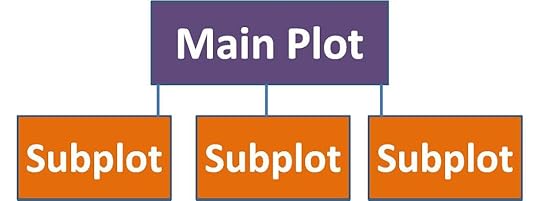Subplots - The Meat & Potatoes To Your Main Plot

 Subplots can add interest and complications to your main plot. They're the smaller conflicts that diverge from the main plot for a while, and then return to be completed within the resolution of the larger main plot. If you're writing a series, some minor subplots may be resolved in later books.
Subplots can add interest and complications to your main plot. They're the smaller conflicts that diverge from the main plot for a while, and then return to be completed within the resolution of the larger main plot. If you're writing a series, some minor subplots may be resolved in later books.Subplots allow your readers to learn more about secondary character relationships without the pressures of the main plot's demands. You'll be able to take your readers to places the main plot won't visit. They'll provide new information, conflicts, and complications to enhance your main plot. Characters—main and strong secondary characters—are your best sources for effective subplots.
Giving your main character more than one conflict to confront adds more dimension to the story and keep the reader wanting to learn more. Say your character gets involved in a murder, that's the main plot. But he's also involved with a woman and can't get over his first wife's death. Since the murder is the main plot, the developing romance becomes a strong subplot.
Another subplot could be your main character being connected to a neighborhood kid who is following in the footsteps of his older brother into gang life. Maybe your main character tries to help this kid stay on the straight and narrow path. This relationship could offer insights into your main character's childhood. Giving the reader knowledge that the main character has flaws is a compelling hook.
Subplots can provide inside information, which can create suspense. They can also reveal a villain's motivations or explain a character's confusing actions. Subplots can also reveal a backstory. They offer a great opportunity for readers to spend time with interesting secondary characters.
Be careful not to have too many subplots. Once a subplot holds the reader's attention as strongly as the main plot, it's no longer a subplot. You can have a main plot disappear for a while, but be careful not to lose your reader from your main plot. If you find yourself spending more time and energy on a subplot than on the main plot, you may want to step back and reconsider your story plot. Maybe your subplot should be your main plot.
You can begin a subplot anywhere that seems appropriate. If two characters meet a third of the way into your story and their relationship drives the subplot, that's where you should begin it. If it's going to be part of the story from beginning to end, introduce it early in your novel, possibly within the first three or four chapters. Just be sure to make sense of your story's dramatic arc.
Make sure you don't choke on the ending of your subplot. Be careful not to pack all the resolutions to your subplots in the final chapter. Your readers can feel overwhelmed by an avalanche of small endings. You can resolve subplots before or after the climax and the main plot resolution. You may try resolving a subplot during the climax scene, as long as it doesn't weaken the tension of your peak scene.
And finally, please don't leave any loose ends. Be sure your subplot ties to the main plot, or it will distract from it. Obviously, if your subplot involves your main character, it's automatically tied into the main plot. Don't lead your readers astray on a minor character's actions in a subplot. They'll end up enjoying the subplot more than the main plot and weakened your story. If your subplot deepens the characterization of our main character, that's probably enough.
I hope this helps you create a meat and potatoes type of subplot while enhancing your story and keeping your reader hooked to the very end.
Remember, keep on writing...
Published on December 31, 2018 04:00
No comments have been added yet.



